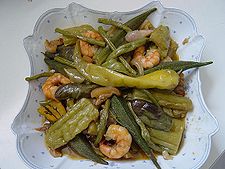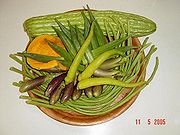
Pinakbet
Encyclopedia


Ilocano people
The Ilocano or Ilokano people are the third largest Filipino ethnolinguistic group. Aside from being referred to as Ilocanos, from "i"-from, and "looc"-bay, they also refer to themselves as Samtoy, from the Ilocano phrase "sao mi ditoy", meaning 'our language here.' The word "Ilocano" came from...
dish, from the northern regions
Ilocos Region
The Ilocos region or Region I is a Region of the Philippines and is located in the northwest of Luzon. It borders to the east the regions of the Cordillera Administrative Region and Cagayan Valley and to the south the region of Central Luzon...
of the Philippines
Philippines
The Philippines , officially known as the Republic of the Philippines , is a country in Southeast Asia in the western Pacific Ocean. To its north across the Luzon Strait lies Taiwan. West across the South China Sea sits Vietnam...
, although it has become popular throughout the archipelago. The word is the contracted form of the Ilocano word pinakebbet, meaning "shrunk" or "shriveled". The original Ilocano pinakbet uses bagoong
Bagoong Terong
Bagoong Terong or bagoong, and bugguong in the Ilocano language, is a common ingredient used in the Philippines and particularly in Northern Ilocano cuisine. It is made by salting and fermenting the bonnet mouth fish. This bagoong is coarser than Bagoong Monamon, and contains fragments of the...
("bugguong" in Ilokano), of fermented monamon
Bagoong Monamon
Bagoong monamon, bagoong monamon-dilis, or simply bagoong and bugguong munamon in Ilocano, is a common ingredient used in the Philippines and particularly in Northern Ilocano cuisine. It is made by fermenting salted anchovies which is not designed, nor customarily used for immediate consumption...
or other fish, while further south, bagoong alamang is used. The basic vegetables used in this dish include native bitter melon
Bitter melon
Momordica charantia, called bitter melon or bitter gourd in English, is a tropical and subtropical vine of the family Cucurbitaceae, widely grown in Asia, Africa, and the Caribbean for its edible fruit, which is among the most bitter of all fruits...
, eggplant, tomato
Tomato
The word "tomato" may refer to the plant or the edible, typically red, fruit which it bears. Originating in South America, the tomato was spread around the world following the Spanish colonization of the Americas, and its many varieties are now widely grown, often in greenhouses in cooler...
, okra
Okra
Okra is a flowering plant in the mallow family. It is valued for its edible green seed pods. The geographical origin of okra is disputed, with supporters of South Asian, Ethiopian and West African origins...
, string beans, chili pepper
Chili pepper
Chili pepper is the fruit of plants from the genus Capsicum, members of the nightshade family, Solanaceae. The term in British English and in Australia, New Zealand, India, Malaysia and other Asian countries is just chilli without pepper.Chili peppers originated in the Americas...
s, parda, winged bean
Winged bean
The Winged bean , also known as the Goa bean and Asparagus Pea and Winged Pea, is a tropical legume plant native to New Guinea. It grows abundantly in hot, humid equatorial countries, from the Philippines and Indonesia to India, Burma, Thailand and Sri Lanka. It does well in humid tropics with high...
s, and others. Root crops and some beans like camote
Sweet potato
The sweet potato is a dicotyledonous plant that belongs to the family Convolvulaceae. Its large, starchy, sweet-tasting, tuberous roots are an important root vegetable. The young leaves and shoots are sometimes eaten as greens. Of the approximately 50 genera and more than 1,000 species of...
, patani, kadios
Pigeon pea
The pigeon pea , also known as tropical green pea, toor dāl or arhar dāl , ತೊಗರಿ ಬೇಳೆ kadios , or Congo pea or gungo pea , pois Congo , gandul , gunga pea, or no-eye pea, [Cajanus...
are also optionally added. The young pod of marunggay
Moringa oleifera
Moringa oleifera, the word Moringa probably came from dravidian language Tamil and commonly referred to as "Shojne" in Bengali, "Munagakaya" in Telugu,"Shenano" in Rajasthani,...
is also added. It is usually spiced with ginger
Ginger
Ginger is the rhizome of the plant Zingiber officinale, consumed as a delicacy, medicine, or spice. It lends its name to its genus and family . Other notable members of this plant family are turmeric, cardamom, and galangal....
, onions, or garlic
Garlic
Allium sativum, commonly known as garlic, is a species in the onion genus, Allium. Its close relatives include the onion, shallot, leek, chive, and rakkyo. Dating back over 6,000 years, garlic is native to central Asia, and has long been a staple in the Mediterranean region, as well as a frequent...
. A Tagalog
Tagalog people
The Tagalog people are an ethnic group in the Philippines. The name Tagalog comes from either the native term tagá-ilog, meaning 'people living along the river', or another native term, tagá-alog, meaning 'people living along the ford', a ford being a shallow part of a river or stream where people,...
version usually includes calabaza
Calabaza
Calabaza is a term that can be applied to a variety of gourds and melons grown throughout the world.-Etymology :The word calabaza is derived from the Persian term for melon . The French term "calabasse", and hence "calabash" is based on the older Spanish...
. Most of these vegetables are easily accessible, and are grown in backyards and gardens of most Ilocano households. As its name suggests, it is usually cooked until almost dry and shriveled; the flavors of the vegetables are accentuated with shrimp paste. In some cases, lechon
Lechon
Lechón is a pork dish in several regions of the world, most specifically Spain and its former colonial possessions throughout the world. The word lechón originated from the Spanish term leche ; thus lechón refers to a suckling pig that is roasted...
, chicharon, or other meats (most commonly pork) are added. It is considered a very healthy dish, and convenient in relation to the harsh and rugged, yet fruitful Ilocos region of the Philippines.
The vegetable dish pinakbet is more than a regional cuisine. It is an enduring symbol of the Ilocano palate and a lucid display of the Ilocanos’ history of contestations and struggles with the physical and social environment. The recipe weaves intimations of the cultural productions of the Ilokanos' transaction to their arid and less productive land. (Caday, 2009)
Pinakbet is similar to the Provençal (French) vegetable stew ratatouille
Ratatouille
Ratatouille is a traditional French Provençal stewed vegetable dish, originating in Nice. The full name of the dish is ratatouille niçoise.- Origin :...
except for its sauce.
See also
- DinengdengDinengdengDinengdeng is a dish of the Ilocano people of the Philippines, similar to pinakbet. It is classified as a bagoong soup based dish...
Dinengdeng is a term usually used by Ilocanos pertaining to any vegetable dish. Though different, dinengdeng is often used interchangeably with pinakbet. Yet, these two are different in terms of procedure in cooking and even in terms of ingredients.
External links
- Recipe for Pinakbet
- Pinakbet Republic - foodblog that "demystifies Ilokano food" and features "rave and rants on food and cuisine of the Ilokanos"

